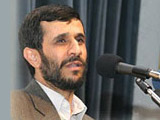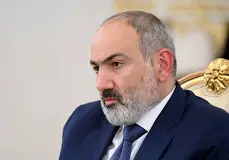|
|
TODAY.AZ / Politics
Gulf News: "Why some parts of Iran are beyond Ahmadinejad's reach"
31 May 2006 [10:19] - TODAY.AZ

The idea was to settle long-standing local problems in a single sitting of the Cabinet. However, as Ahmadinejad prepares to mark the first anniversary of his presidency it looks increasingly unlikely that he could keep that promise.
So far Ahmadinejad has a record of visiting nearly half of the provinces and is determined to do some more soon. Nevertheless, quite a few provinces have become no-go areas for the president. The reason is increasing ethnic and sectarian tensions in parts of the country.
The latest province to be affected is East Azerbaijan, which Iranians refer to as "Iran's head".
Last week Tabriz, capital of East Azerbaijan, was the scene of anti-government demonstrations that, despite claims by some exile groups, were largely spontaneous. The trigger for the protests was a cartoon published in a government-owned newspaper depicting Azeris, Iran's largest ethnic and linguistic minority, as "dumb cockroaches".
No one knows how many Iranians have Azeri roots. However, official statistics indicate that Azeris form a majority in four provinces: East Azerbaijan, West Azerbaijan, Ardebil and Zanjan. Taking into account Azeris living in other provinces, at times for generations, the community may be 15 million strong.
For centuries, Azeris have played a leadership role and served as the vanguard of such historic events as the 1906 Constitutional Revolution. Their Shi'ite faith and passionate attachment to Iranian nationhood have made them the backbone of the modern Iranian nation-state.
Azeris also played a crucial role in sweeping the late Ayatollah Ruhollah Khomeini to power in 1979. Immediately after the revolution, however, Khomeini moved to stop the rise of Azeri influence in his newly-created Islamic Republic.
One such moves was to defrock Grand Ayatollah Kazem Shariatmadari, an eminent Azeri theologian and one of the most respected Shi'ite leaders of the last century. Most Azeris saw the move as a direct attack on themselves. They were also outraged by the fact that Khomeini had forgotten that he owed his own title of Ayatollah to a decree signed by Shariatmadari in 1963.
What was perceived as the Islamic Republic's anti-Azeri stance came into sharper focus in 1989 when the then President Hashemi Rafsanjani flew to Baku, capital of Soviet Azerbaijan, to call on the population not to seek independence from the USSR.
Rafsanjani's visit came at a time that Baku was still trying to recover from a crackdown launched by Soviet troops, including naval units, on Mikhail Gorbachev's orders. Iranian Azeris had expected Tehran to support their fellow Shi'ites in Soviet Azerbaijan rather than invite them to remain under the Soviet colonial yoke.
There is also tension in the province of Kurdistan, on the border with Iraq, and the Kurdish-majority districts of West Azerbaijan. Some Kurdish opposition groups, including an outfit known as Pejak and an older Communist group known as Komaleh have already embarked on a guerrilla campaign against the Islamic regime.
However, what worries Tehran most is the rising tide of protest by unarmed populations in some Kurdish cities. According to Kurdish opposition sources, hundreds of people have been arrested, often without charge. The government has also closed many Kurdish language publications.
In most cases, the protests appear to have been spontaneous or locally organised. Nevertheless, they have been deemed promising enough for some Kurdish parties to try to assume their leadership. One such is the Kurdish Democratic Party of Iran whose leader Ghani Bolourian has just left Europe for Iraq and is busy setting up a coordination committee to lead what he believes is a burgeoning popular revolt.
President Ahmadinejad is unable to visit any of the three provinces where ethnic Kurds form either a majority or a substantial segment of the population. (Overall, ethnic Kurds account for nine per cent of Iran's population of almost 70 million.)
Another province that faces increasing unrest is Khuzestan that produces almost 80 per cent of Iran's oil. The province is home to most of Iran's estimated 3.2 million ethnic Arabs. Although ethnic Arabs account for fewer than 40 per cent of the province's population, there are districts, such as Dasht Mishan and Susangerd, where they represent up to 80 per cent.
Here, too, ethnic and linguistic grievances, combined with dissatisfaction with Tehran's economic and social policies, have created an explosive situation, which the authorities have tried to control by force.
The real no-go area for Ahmadinejad, however, is the southeastern province of Sistan and Baluchistan, a vast region of mountains and deserts bordering Pakistan and Afghanistan. In Tehran call it "the wild frontier" if only because it has been the scene of frequent battles between security forces and armed insurgents. Last month alone 20 Iranian security men were killed by what Tehran has called "bandits", said to be operating from Pakistan.
Some of the violence in Sistan and Baluchistan may be the work of armed drug smugglers and contraband networks backed by local tribes. Nevertheless, at least two political groups, the Baluch Liberation Front (BLF), a leftist outfit, and the Baluch Protection Council claim to be active in the province. Both had headquarters in Baghdad before 2003 and may now have transferred to Pakistan.
One is the arc of steppes on Iran's northeast frontier with the Republic of Turkmenistan. There, ethnic Turkmen, representing 2 per cent of Iran's population, form a majority and, being Sunni Muslims, have never warmed up to the government set up by Shi'ite mullahs. Iran's Turkmen were the first to rise against the Islamic Republic in 1979 when, with the help of a Marxist-Maoist guerrilla group known as People's Fedayeen, they set up a short-lived people's republic of their own. The "people's republic" was crushed by Khomeini at the cost of hundreds of Turkmen lives.
The other possible flashpoint is the Iranian Talesh on the Caspian Sea. There, Sunni Muslims, speaking non-Persian dialects, form a majority of the 1.5 million population. They never warmed up to the regime of Shi'ite mullahs, and have staged periodical revolts that often provoked a harsh response from Tehran.
Speaking in Indonesia this month, President Ahmadinejad spoke of his ambition to unite and lead the Muslim world in a "clash of civilisation" against the "Infidel". Many in Iran believe that he should first address the grievances that have made it impossible for him to visit so many provinces, and before it is too late.
By Amir Taheri
/www.gulfnews.com/
URL: http://www.today.az/news/politics/26723.html
 Print version
Print version
Connect with us. Get latest news and updates.
See Also
- 10 May 2025 [19:20]
Heydar Aliyev’s vision and its lasting impact on Azerbaijan - 10 May 2025 [17:48]
Ministry of Defense Leadership pays tribute at Alley of Honor - 10 May 2025 [17:25]
"One nation, two states" more relevant than ever, says Turkish Ambassador to Azerbaijan - 10 May 2025 [16:23]
Azerbaijan's Ministry of Defense provides housing to military personnel as part of Social Protection Program - 10 May 2025 [15:50]
President Ilham Aliyev meets with residents who moved to Kangarli village in Aghdam and presented them with keys to their new homes - 10 May 2025 [15:46]
Heydar Aliyev's leadership laid foundations for Azerbaijan's sovereignty and future development - 10 May 2025 [15:32]
President Ilham Aliyev examines newly built individual houses in Aghdam’s Kangarli village - 10 May 2025 [15:27]
Nursery-kindergarten inaugurated in Aghdam’s Kangarli village - 10 May 2025 [15:23]
President Ilham Aliyev attends inauguration of Kangarli village secondary school in Aghdam - 10 May 2025 [15:21]
Azerbaijan’s Embassy in Washington Commemorates 102nd Anniversary of National Leader Heydar Aliyev
Most Popular
 President Ilham Aliyev meets with residents who moved to Kangarli village in Aghdam and presented them with keys to their new homes
President Ilham Aliyev meets with residents who moved to Kangarli village in Aghdam and presented them with keys to their new homes
 Pashinyan Heads to Moscow. Will Macron and Kallas Be Offended?
Pashinyan Heads to Moscow. Will Macron and Kallas Be Offended?
 Ministry of Defense Leadership pays tribute at Alley of Honor
Ministry of Defense Leadership pays tribute at Alley of Honor
 Azerbaijan and Morocco strengthen employment ties with new cooperation plan
Azerbaijan and Morocco strengthen employment ties with new cooperation plan
 President Ilham Aliyev shares footage on 102nd anniversary of National Leader Heydar Aliyev’s birth
President Ilham Aliyev shares footage on 102nd anniversary of National Leader Heydar Aliyev’s birth
 Azur Air Flight to Antalya returns to Mineralnye Vody due to technical malfunction
Azur Air Flight to Antalya returns to Mineralnye Vody due to technical malfunction
 Azerbaijan's Ministry of Defense provides housing to military personnel as part of Social Protection Program
Azerbaijan's Ministry of Defense provides housing to military personnel as part of Social Protection Program
